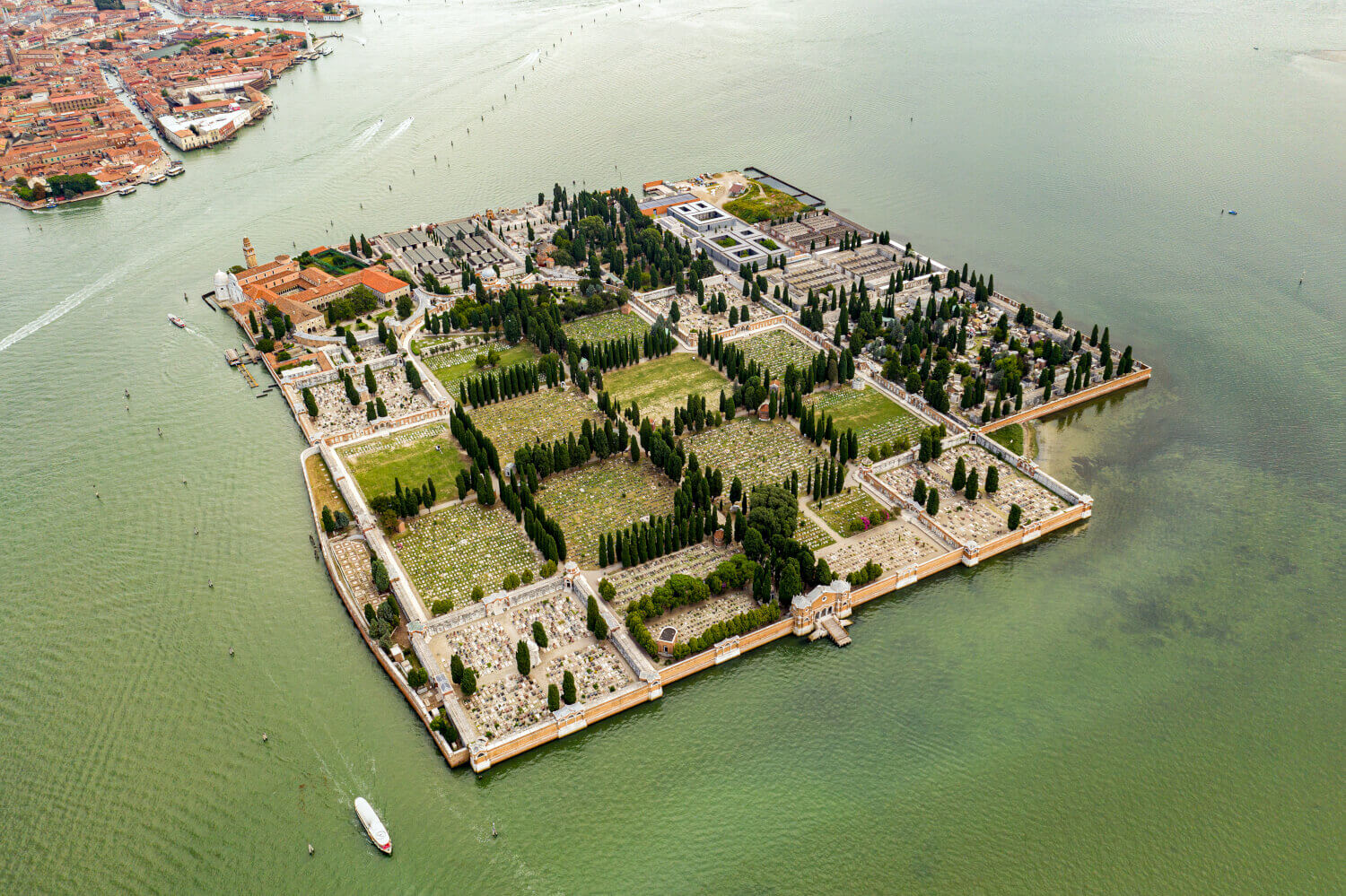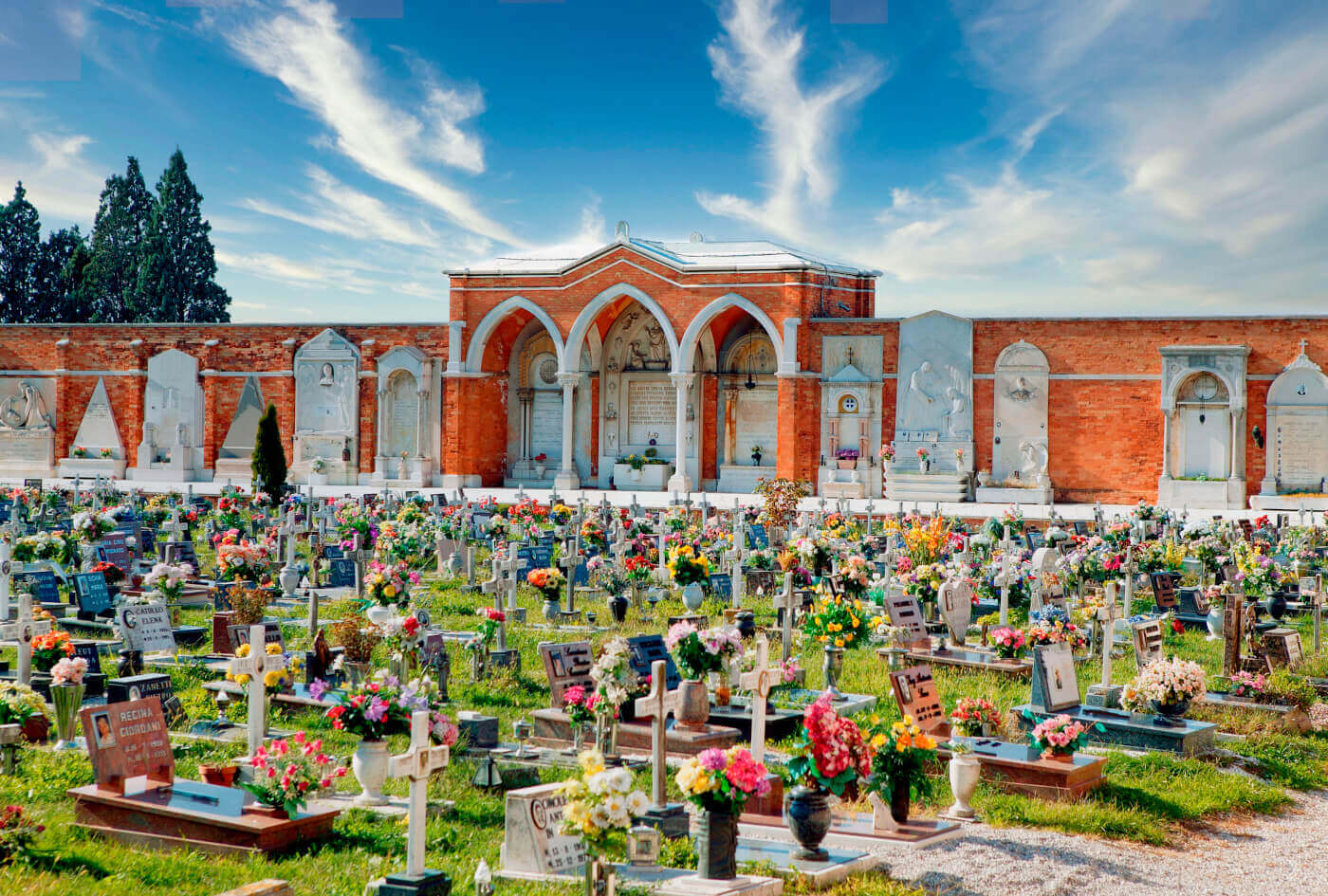Island of San Michele: the cemetery of Venice
In the Venetian lagoon, between calm waters and dense canals, stands the Island of San Michele, also known for centuries as “the cemetery of Venice”.
This mysterious place, however, is not only a site of eternal rest, but it is a real open-air museum that tells of art, history and spirituality. Here, in fact, time seems to have stopped, offering a perfect refuge for those who wish to reflect and remember.
In San Michele, the high red brick walls that surround the island, dotted with the green foliage of cypresses, create an evocative picture, which combines natural beauty with the work of man.
The history of the Island of San Michele
The Island of San Michele, with its solemn atmosphere, is one of the (many) hidden gems of the Venetian lagoon, with a fascinating history full of transformations.
Initially, the island was divided into two parts: St. Michael and St. Christopher. Between 1835 and 1839, however, the canal separating the two islands was filled in, and so they merged into a single entity. This intervention, part of a larger project, was aimed at creating a central cemetery for Venice, thus responding to the new needs imposed by the 1804 Edict of Saint Cloud by Napoleon Bonaparte, which forbade burials within the city limits.
The island, characterized by its red brick walls and its many cypresses, has recently seen expansion and restoration interventions; between 1998 and 2013, for example, an expansion and redevelopment project, developed by David Chipperfield Architects, has further transformed the island. This expansion proposal not only respected the historical and artistic characteristics of the island, but also introduced new spaces that invite meditation and remembrance.
The combination of ancient traditions with contemporary design makes the Island of San Michele a place where past and present meet in a continuous dialogue, offering visitors a unique, sometimes touching experience.

The church of San Michele and the convent
In the centre of the island of San Michele is the church of the same name, built between 1469 and 1479 by the architect Mauro Codussi. This place of worship is a pioneering example of Renaissance architecture in Venice, with a harmonious and proportionate façade, adorned with a Gothic statue of the Madonna and Child.
Right next to St. Michael’s Church is the convent, which has had an equally interesting history. Founded in 1212, this place was inhabited by the Camaldolese until 1811, when it was suppressed by a Napoleonic decree. In 1829, the Reformed Franciscan Friars Minor took possession of it, restoring it and continuing the tradition of study and meditation.
The monastery library still preserves important prints from the seventeenth and eighteenth centuries.
The Cemetery
The cemetery of San Michele was designed in 1808 by Gianantonio Selva and later enlarged following the union of the islands of San Cristoforo and that of San Michele.
The transformation of the island into such an extensive cemetery has made it possible to create a unique burial place, which over time has become the eternal rest not only for Venetians, but also for many illustrious personalities from all over the world, including the poet Ezra Pound, the composer Igor Stravinsky and the dancer Sergej Diaghilev.
In addition, walking among its tombs, it is possible to admire buildings signed by great sculptors and painters of the last centuries, who have often transformed the tombs into real works of art, with sculptures and decorations that reflect the rich artistic tradition of Venice.

Timetables and how to reach the Island of San Michele
The Island of San Michele is easily accessible by ACTV water buses from the main stops in Venice, such as Piazzale Roma, Stazione FS, Fondamenta Nove and San Zaccaria. The vaporetto lines 41 and 42 offer direct access to the island.
The opening hours of the cemetery vary seasonally:
- April 1 to September 30: 7:30 am – 6:00 pm
- October 1 to March 31: 7:30 am – 4:00 pm
- Christmas, Easter and New Year’s Eve: Closes at 12:00
- All Souls’ Day (November 1 – November 4): 7:30 a.m. – 5:00 p.m.
Access is allowed up to 30 minutes before closing time. It is very important to respect the rules of conduct during the visit, maintaining respect for the deceased and the surrounding environment.
The Island of San Michele represents a place where history, art and spirituality come together, offering visitors a unique perspective on Venetian culture and eternity. A visit to this monumental cemetery is not only a journey into the past, but also an opportunity to reflect on the beauty and fragility of life.
Discover an unusual Venice with Camping Ca’Savio
Camping Ca’Savio is the ideal base for exploring Venice and its surroundings.
Located in a strategic position, from the campsite it is in fact possible to easily reach the entire Venetian lagoon, even those lesser-known places of great historical and artistic interest, such as the Island of San Michele.
Reaching this unusual island from Camping Ca’Savio is simple and pleasant: guests can in fact arrive by bicycle to Treporti and take a direct vaporetto to Fondamente Nuove, from where it is easy to reach the island. This route allows you to combine a bike ride with a cultural visit, offering a very impressive experience.
Plan your trip today and discover a corner of Venice that will remain forever in your heart!
